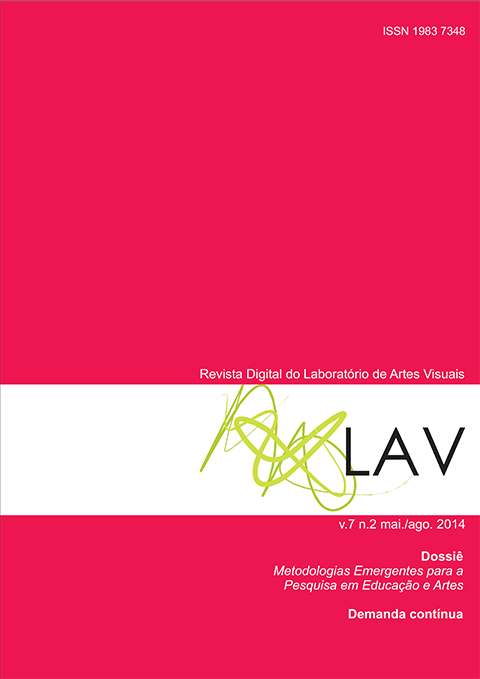Visual narrative and interpretative representation: the contribution of new illustration trends for critical thinking in adolescents
DOI:
https://doi.org/10.5902/1983734810655Keywords:
Illustration, Art Education, Visual Communication, Critical ThinkingAbstract
The fact that the illustrator feels, today, part of a globalized world and a citizen belonging to that world, which is getting smaller every day, offers new stories and new ways of seeing and interpreting what's around us.
Over the following pages, we propose new ways of viewing critical thinking of adolescents in the context of art education, particularly in the exploration of new trends in illustration.
As educators, we must remind ourselves of the responsibility of monitoring the adolescents in their transition to adulthood. We shall seek to provide alternatives, allowing the young to build reading of reality, in their growth and maturity.
Downloads
References
ALMEIDA, A. A educação estético-visual no ensino escolar (2.ª ed). Lisboa: Livros Horizonte, 1980.
ÁNGELES, J. Creatividad Publicitaria Concepto, Estrategias y Valoracion. Navarra: Eunsa, 1996.
BARBOSA, M. A128: A documentary about illustration. Toronto, 2011. (Consultado em 17/01/2012 [http://www.appliedartsmag.com/blog/?p=5810])
BAHIA, S. & GOMES, N. A criatividade como ferramenta de flexibilização de limites. Revista Imaginar, n.º 52, 2010, p. 59-64. (Consultado em 20/12/2011 [http://www.apecv.pt/anexos/imaginar/nr52.pdf])
BECHARA, E. Moderna gramática portuguesa (37.ª ed. revista e ampliada). Rio de Janeiro: Lucerna, 2003.
BRONOWSKI, J. Arte e conhecimento : ver, imaginar, criar. Lisboa: Edições 70, 1983.
CAVALCANTI, J. A criatividade no processo de humanização. Saber (e) Educar, n.º 11, 2006, p. 89-98.
CHARRÉU, L. Imagem global e cultura visual: sobre o que se pode aprender no espaço mediático. In: V. Trindade, N. Trindade & A.A. Candeias (Orgs.). A Unicidade do Conhecimento. Évora: Universidade de Évora, 2007, p. 1-12. (Consultado em: 17/01/2012 [http://pt.scribd.com/leonardo_charr%C3%A9u/d/53296321-CHARREU-L2007-Imagem-Global-e-Cultura-Visual])
COELHO, C. Artistas de palmo e meio. Revista Imaginar, n.º 51, 2008. (Consultado em 11/01/2012 [http://www.apecv.pt/anexos/imaginar/nr51.pdf])
COELHO, S. As imagens invisíveis. In: Fernandes, M., Gonçalves, J.A., Bolina, M., Salvado, T. & Vitorino, T. (orgs.) Actas do 5º CONGRESSO DA SOCIEDADE PORTUGUESA DE CIÊNCIAS DA EDUCAÇÃO. O Particular e o global no virar do Milénio: Cruzar Saberes em Educação. Lisboa: Ed. Colibri, 2002, p.825-833.
COSTA, J. & MELO, A. Dicionário da língua portuguesa (8ª ed. revista e actualizada). Porto: Porto Editora, 2001.
DUNCUN, P. Conceitos Chave da Educação para a Cultura Visual. Revista Imaginar, n.º 52, 2010, p 4-13. (Consultado em 18/12/2011 [http://www.apecv.pt/anexos/imaginar/nr52.pdf])
DURAN, T. Leer antes de leer. Salamanca: Anaya, 2002.
FLEMING, M. Entre o medo e o desejo de crescer: psicologia da adolescência. Lisboa: Afrontamento, 2005.
FONTAO, M. La imagen como mediadora en el aprendizaje escolar. CONGRESSO GALAICO-PORTUGUÊS DE PSICOPEDAGOGIA. Congresso Galaico-Português de psicopedagogia : actas (1.ª ed.). Braga: Universidade do Minho, 1 vol, 2001, p. 469-475.
GOLSE, B. O desenvolvimento afectivo e intelectual da criança (1.ª ed). Lisboa: Climepsi, 2005.
GRÖLLER, M. & VIOLA, I. Smart Visibility in Visualization. In: Proceedings of EG Workshop on Computational Aesthetics Computational Aesthetics in Graphics, Visualization and Imaging. Viena: Institute of Computer Graphics and Algorithms,
Vienna University of Technology, 2005, p. 209-216 (Consultado em 20/01/2012 [http://www.cg.tuwien.ac.at/courses/CG2/SS2002/IllustrativeVisualization.pdf)
MANO, V. & ZAGALO, N. Criatividade: sujeito, processo e produto. 8.º Congresso Lusocom. 2009, p. 1213-1229. (Consultado em 10/01/2012 [http://conferencias.ulusofona.pt/index.php/lusocom/8lusocom09/paper/viewFile/205/18
).
MALE, A. Illustration: a theoretical and contextual perspective. Londres: AVA Publishing, 2007.
MENÉRES, M. Imaginação. Lisboa: Difusão Cultural, 1993.
MESTRE, M. A ilustração inventa e a imaginação vê. Revista Pé de Página, (1). Beja: Biblioteca Municipal de Beja, 2003, p. 36-37.
MUNARI, B. Fantasia. Lisboa: Edições 70, 2007.
PAPALIA, D. & OLDS, S. Desenvolvimento humano (7.ª ed). Porto Alegre: Artes Médicas, 2000.
PIAGET, J. The Psychology of Intelligence (reimpressão). Londres: Routledge, 2004.
PIAGET, J. The Origin of Intelligence in the Child: Jean Piaget: Selected Works (reimpressão). Londres: Routledge, 1998.
PIAGET, J. The principles of genetic epistemology (reimpressão). Londres: Routledge, 1998.
PERKINS, D. The intelligent eye: learning to think by looking at art (3.ª ed). Los Angeles: The Getty Education Institute for the Arts, 1994.
RIBEIRO, C. Metacognição: um apoio ao processo de aprendizagem. Psicologia: reflexão e crítica 16 (1)., 2003, p. 109-116. (Consultado em 10/01/2012 [http://www.scielo.br/pdf/prc/v16n1/16802.pdf]).
SÊCO, J. Chamados pelo nome: da importância da afectividade na educação da adolescência. Lisboa: Instituto de Inovação Educacional, 1997.
SOUSA, A. Educação pela arte e artes na educação, 3.º vol: música e artes plásticas. Lisboa: Instituto Piaget, 2003.
STRECHT, P. Interiores: uma ajuda aos pais sobre a vida emocional dos filhos. Lisboa: Assírio & Alvim, 2001. (Consultado em 07/01/2012 [http://www.scielo.br/pdf/%0D/prc/v16n1/16802.pdf]).






